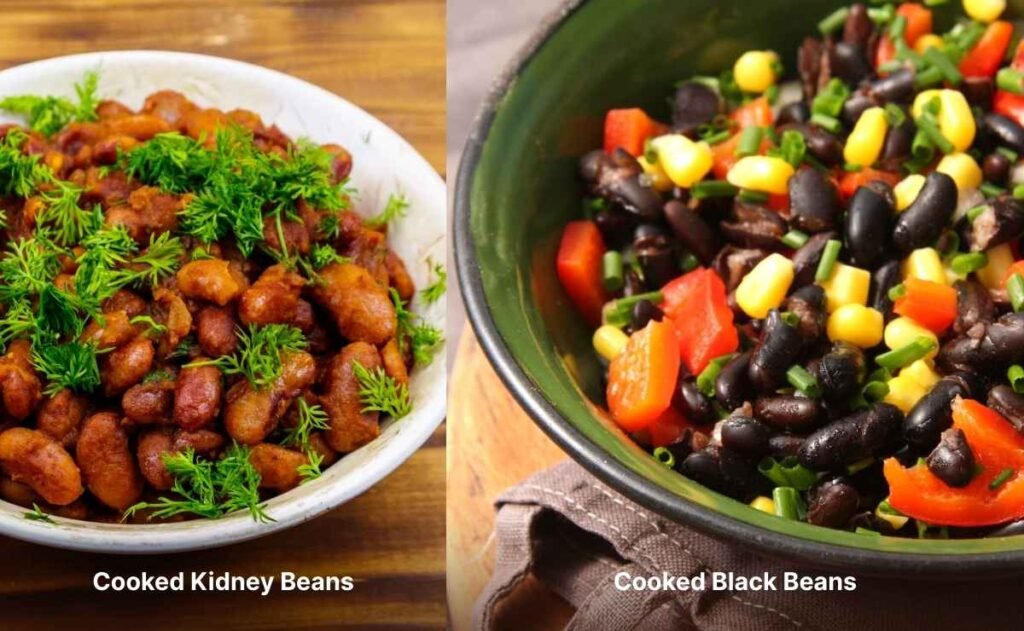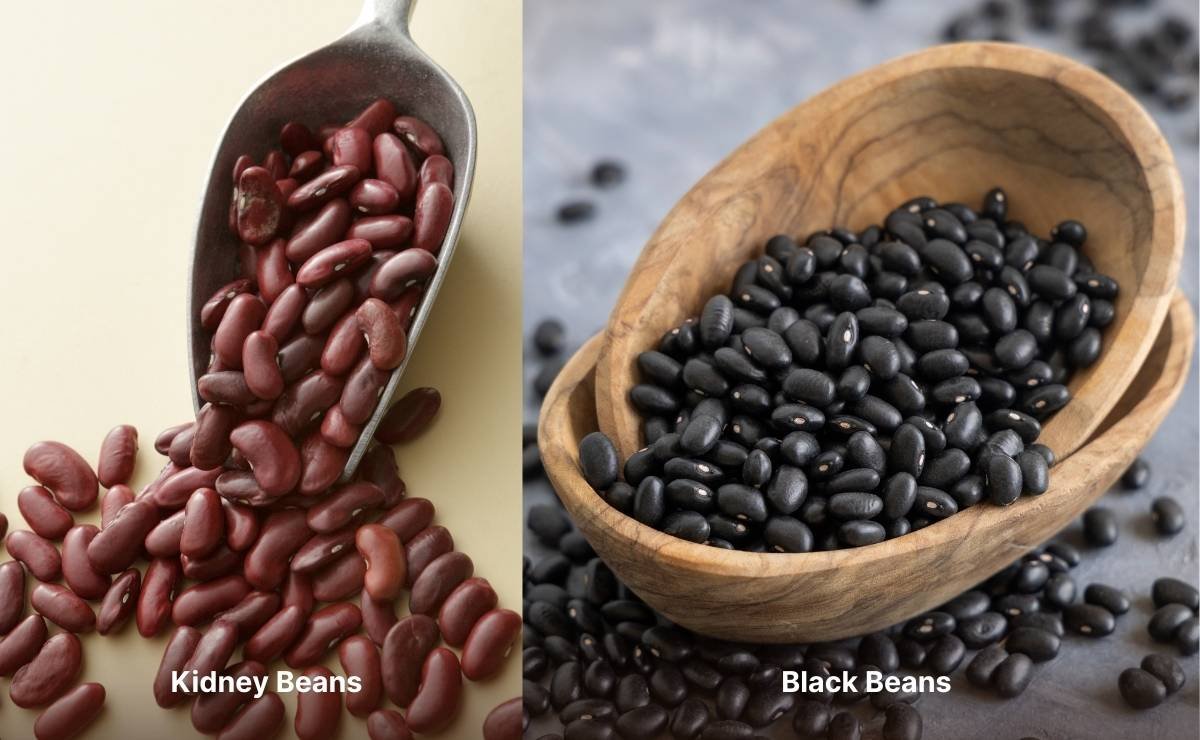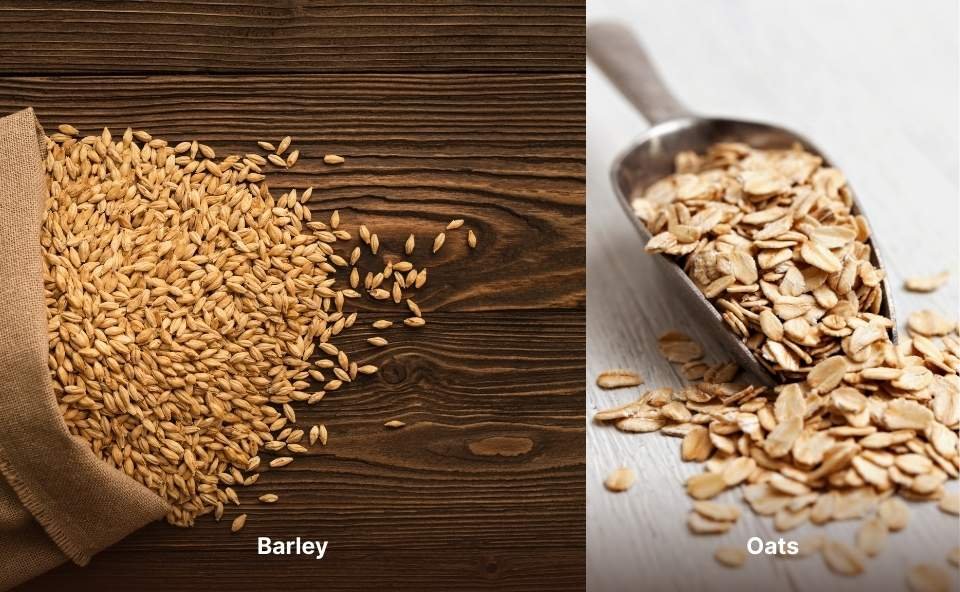When choosing the right beans, I always find myself torn between black and kidney beans. Both are nutritional powerhouses packed with protein, fiber, and essential nutrients. It can be an overwhelming decision, especially since they offer unique benefits. Whether cooking a fiber-packed meal or adding plant-based protein, these beans are incredibly versatile and economical.
The choice between black and kidney beans often depends on their taste, texture, and cooking time. Both are loaded with antioxidant activity and can enhance the flavor of any dish. But to truly get the full benefits, it’s important to know how to cook them properly to reduce antinutrients and help with digestion and nutrient absorption. These beans are not just a staple in my kitchen—they’re a perfect fit for many meals!
Let’s dive in and find out what makes these beans stand out!
🫘Black Beans
Growing up, I always admired how South America introduced us to some of the most nourishing foods, like black turtle beans. These small, round legumes resemble turtle shells with their shiny, rugged exterior and matte black coating. Known in Latin America, Central America, and the Caribbean as caviar criollo or frijoles negros, their tiny white dots and slivers make them instantly recognizable. Only about half an inch in length, when cooked, they release a deep black pigment that turns soups, broths, and rice dishes into a beautiful, rich color. It’s easy to see why they’re a true culinary staple in Tex-Mex and Caribbean dishes.
I love their mild, earthy flavor, whether stuffed in tacos, wrapped in burritos, or tossed into fresh salads. Their soft, velvety texture and rich creaminess make them perfect for vegetarian patties, meatballs, and desserts. When processed, they work wonderfully as binding agents. They’re a powerhouse of protein, dietary fiber, flavonoids, and plant-derived anthocyanins, known for their antidiabetic, anti-inflammatory, and antimicrobial effects. After spending time cooking black beans through different recipes, I genuinely believe these humble beans have earned their place as a classic across kitchens worldwide.
Curious how black beans compare to another favorite? Check out my whole Black Beans vs Pinto Beans guide—it’s a tasty match-up you won’t miss!
🫘Kidney Beans
In my kitchen adventures, kidney beans have always stood out. Originating about 7000 years ago in Central America and South America, they were first paired with corn and squash, and by the 15th century, they became a staple in global cuisines for their adaptability, nutritional value, and ease of storage. From spicy chili con carne to hearty bean soups, these essential ingredients shine with their distinct kidney-like shape and vivid, deep red color. However, white, brown, and speckled varieties offer even more visual fun beyond the usual red beans.
They’re loved for adding heartiness with their firm, creamy texture and mildly nutty, earthy flavor. Thanks to their thicker skin, I love how they take on flavors during simmered dishes and still hold form through long hours of cooking. Plus, their nutritional content is impressive — they’re packed with antioxidants, high in protein and minerals, fitting into two food groups. About an inch long, light red and dark red varieties bring great color and genuine heartiness to all kinds of dishes, making them one of my pantry must-haves.
Want to see how kidney beans compare to other classics? Dive into my whole Kidney Beans vs Pinto Beans and Kidney Beans vs Red Beans comparisons—these are flavorful showdowns you’ll love exploring!
Now that we’ve explored both ingredients, let’s dive into how they stack against each other!
💪Black Beans vs Kidney Beans: Which One Should You Choose for Your Health?
When choosing between black beans and kidney beans, I’ve always wondered which fits better for healthy eating. Both are rich in nutrients and offer profound health benefits, but their nutrient differences make them unique. Whether you’re focused on protein and fiber or meeting specific dietary needs, one might be your better choice.
Let’s dive in and see what each bean brings—and how your decision can match your health goals!
Black Beans: Nutrition Highlights
- High in Fiber: I love black beans’ high fiber content—about 15g per cooked cup. They’re a great choice to support digestion, balance blood sugar, or stay full longer. I add them to my meals to boost my healthy eating routine!
- Rich in Protein: Black beans are a strong pick for plant-based diets, with around 15g of protein per cooked cup. While they are not a complete source of amino acids, pairing them with grains like rice ensures a complete amino acid profile.
- Packed with Antioxidants: Black beans are loaded with antioxidants, especially anthocyanins—the same kind found in berries, which help reduce inflammation and may protect against metabolic syndrome and other chronic diseases.
- Good Source of Micronutrients: They’re rich in magnesium (about 120mg per cup) and folate (around 256 mcg), essential for bone health, energy production, and muscle function. Their nutritional profile helps you meet key nutrient levels easily.
Canned Options: Canned black beans are a lifesaver for busy days—just rinse them thoroughly to lower sodium levels by about 40%.
Kidney Beans: Nutrition Highlights
- Rich in Protein: Kidney beans also deliver about 15g of protein per cooked cup. Like black beans, pairing them with grains completes their amino acid profile for better protein quality.
- Higher in Iron and Potassium: Kidney beans offer around 3.6mg of iron and approximately 600mg of potassium per cup. These minerals support energy levels, oxygen transport, and healthy blood pressure.
- Supports Blood Sugar Control: Thanks to their high resistant starch content and low glycemic index (GI ~29–38), kidney beans can help regulate blood sugar and improve GI hormone responses after meals.
- Low in Fat: With less than 1g of fat per cup, kidney beans are ideal for anyone with heart-healthy, low-fat eating patterns.
Canned Options: Canned kidney beans are widely available—again, rinsing them is key to reducing sodium levels before adding them to meals.
Both black beans and kidney beans are excellent choices for healthy eating. Black beans shine with their higher fiber content, antioxidants, and magnesium, making them fantastic for digestion and heart health. Kidney beans bring higher iron, potassium, and resistant starch that supports blood sugar balance and metabolic health.
Gluten Content
Both black beans and kidney beans are naturally gluten-free, making them perfect for anyone with celiac disease, gluten intolerance, or just aiming to avoid gluten. I love knowing I can toss them into any meal without a second thought! Just a quick tip: if you’re grabbing canned or pre-seasoned beans, double-check the label—sometimes sauces or seasonings sneak in gluten.
Glycemic Index Score
Thanks to their low glycemic index, both beans are awesome for blood sugar management. Black beans have a GI of around 30, while kidney beans fall between 29 and 38, depending on prep. I lean on them when I want meals that keep my energy stable and cravings low. Slow digestion and steady glucose release make a huge difference!
At the end of the day, your best choice depends on your personal dietary needs. Thankfully, both are low-fat, high-fiber, and nutrient-dense foods with similar calorie counts. No matter your choice, you’re giving your body a true boost—one delicious bite at a time!
📚 Reference:
🕒Cook Time & Methods
When I first began cooking beans at home in the United States, I quickly saw how available black and kidney beans were at any grocery store. Whether grabbing canned ones or planning to purchase dried beans to cook yourself, it’s pretty easy once you know you need water, heat, and a little time. Many helpful links online show popular cooking methods for beans like kidney and pinto beans. Using an Instant Pot or pressure cooker changed everything — they make the process much faster and the results just as tasty.

Cooked black beans vs kidney beans comparison, highlighting their soft textures and rich colors.
Black Beans
- Instant Pot/Pressure Cooker: Unsoaked – 25 minutes, Soaked – 8 minutes
- Stove Top: 1 to 1½ hours
- Slow Cooker: 6 to 8 hours on low, 3 to 4 hours on high
Kidney Beans
- Instant Pot/Pressure Cooker: Unsoaked – 40 to 45 minutes, Soaked – 25 minutes
- Stove Top: 1 to 1½ hours
- Slow Cooker: 6 to 8 hours on low, 3 to 4 hours on high
Note: Always soak kidney beans for at least 5 hours and boil for 10 minutes first to remove toxins.
Even though kidney beans need a little more time than black beans, both can easily fit into any routine, whether you’re in a rush and prefer stovetop methods or love the hands-off magic of a Slow Cooker. No matter what you choose, the long cooking process takes the flavor and texture to a new level.
Kidney Beans Can Be Toxic If Not Cooked Properly
Kidney beans are healthy and economical, but they need the right prep work to eat safely. If not cooked properly, they can cause nausea, vomiting, and even cramping. The key is getting them to the right temperature—using a slow cooker isn’t enough. Boil the beans on the stovetop for 10 minutes, or cook them in the oven to ensure they’re fully cooked and safe. Proper cooking methods are essential to avoid health issues and make them edible and tasty!
💰Cost Comparison
When comparing black beans and kidney beans, both are great, economical options, but have slight price differences. As of April 2025, at Walmart:
- Black Beans: Great Value, 15 oz can, $0.94
- Kidney Beans: Great Value, 15.5 oz can, also $0.94
Both types of canned beans are priced the same, making them affordable pantry staples. For those looking for larger quantities, a 25-lb bag of kidney beans costs $69.95. Prices may vary, so checking the latest market trends is always a good idea!
🥘Recipes
Black Beans Recipes
Black beans are super versatile and a staple in Mexican cuisine and beyond. One of my favorites is refried beans, a savory dish popular in Cuban and Colombian cuisine, especially when paired with plantains. If you’re in a rush, canned black beans make for a quick and delicious option. You can whip up a quick batch of tacos or add them to a hearty dish like Puerto Rican shrimp stew—perfect for a satisfying meal. Here are some of my favorites and also from around the web:
Smoky, hearty, and perfectly seasoned, these Chipotle-style black beans are a quick, cozy, and flavorful favorite for any meal.
Instant Pot Black Beans – a quick, healthy, no-soak recipe packed with bold flavor and ready in under an hour!
A simple and delicious dish combining black beans, diced tomatoes, lime juice, and spices, cooked together for a quick meal.
A flavorful recipe using dried black beans, bay leaf, onion, green bell pepper, and garlic, simmered to perfection for a traditional Cuban dish.
A hearty soup featuring black beans, tomatoes, and a blend of spices, simmered to create a flavorful and comforting dish.
Kidney Beans Recipes
Kidney beans are a go-to in South and Central America. I love them in a lentejas (lentils) dish with plantains—a combo that brings out the perfect mix of flavors. For a time-saving meal, canned kidney beans are an excellent option for making hearty meals like chili or stew in no time. Kidney beans are just so easy to incorporate into your favorite hearty dishes.
A classic North Indian dish featuring kidney beans simmered in a rich, spiced tomato gravy.
A hearty dish featuring kidney beans, ground beef, bacon, and a sweet-savory sauce, perfect for gatherings.
A comforting soup with kidney beans, potatoes, and fried onions, seasoned with beef bouillon for added depth.
❓Frequently Asked Questions
What are the main differences between black beans and kidney beans?
Black beans are smaller, round, and tender, with a slightly sweet flavor. Kidney beans are larger, kidney-shaped, and firmer, with a more earthy taste.
Are black beans or kidney beans healthier?
Both are great options, but black beans pack more fiber and antioxidants, while kidney beans offer more iron and potassium. It’s all about your health goals!
Can I substitute black beans for kidney beans in recipes?
Definitely! Black beans can replace kidney beans in most dishes, though the texture and flavor might change slightly. Choose based on what you like.
Are canned black beans and kidney beans safe to eat without cooking?
Canned kidney beans must be heated to remove toxins, while black beans are safe. Always cook beans properly to stay safe.
How should I cook black beans and kidney beans?
Black beans can be stovetop or slow-cooked, but kidney beans need to be boiled for at least 10 minutes to neutralize toxins before cooking.
🔚Final Thoughts
Ultimately, black and kidney beans are packed with nutrients, each offering unique benefits. Whether you’re after the fiber and antioxidants of black beans or the iron and potassium of kidney beans, both add amazing flavor and nutrition to your meals. The choice is up to your taste and health goals, but either way, you’re bringing something nourishing into your kitchen!

Hi, I’m the voice behind The Bean Bite — someone who’s genuinely obsessed with beans! What started as a simple love for homemade lentil stew turned into a journey of discovering bean varieties, cooking tips, and their amazing health benefits. This site is my way of sharing that joy with you — one bean at a time.



